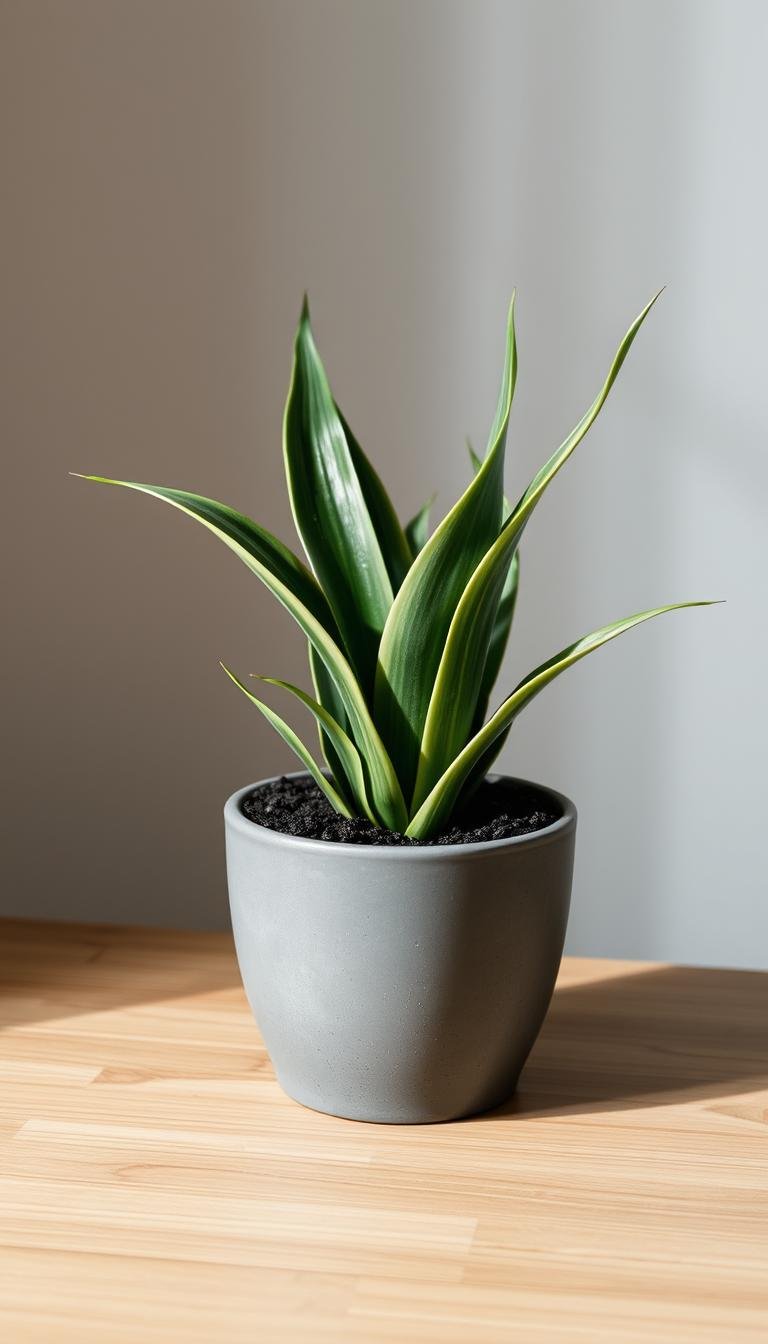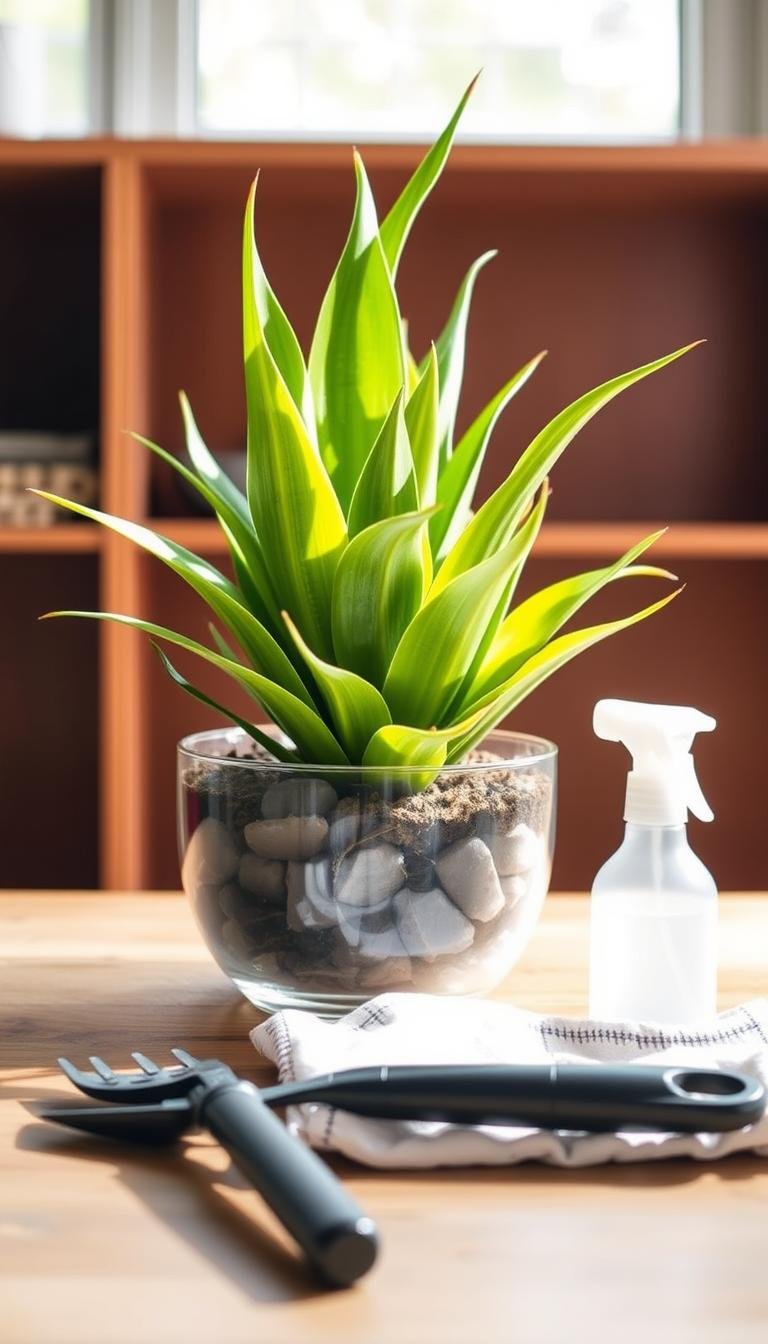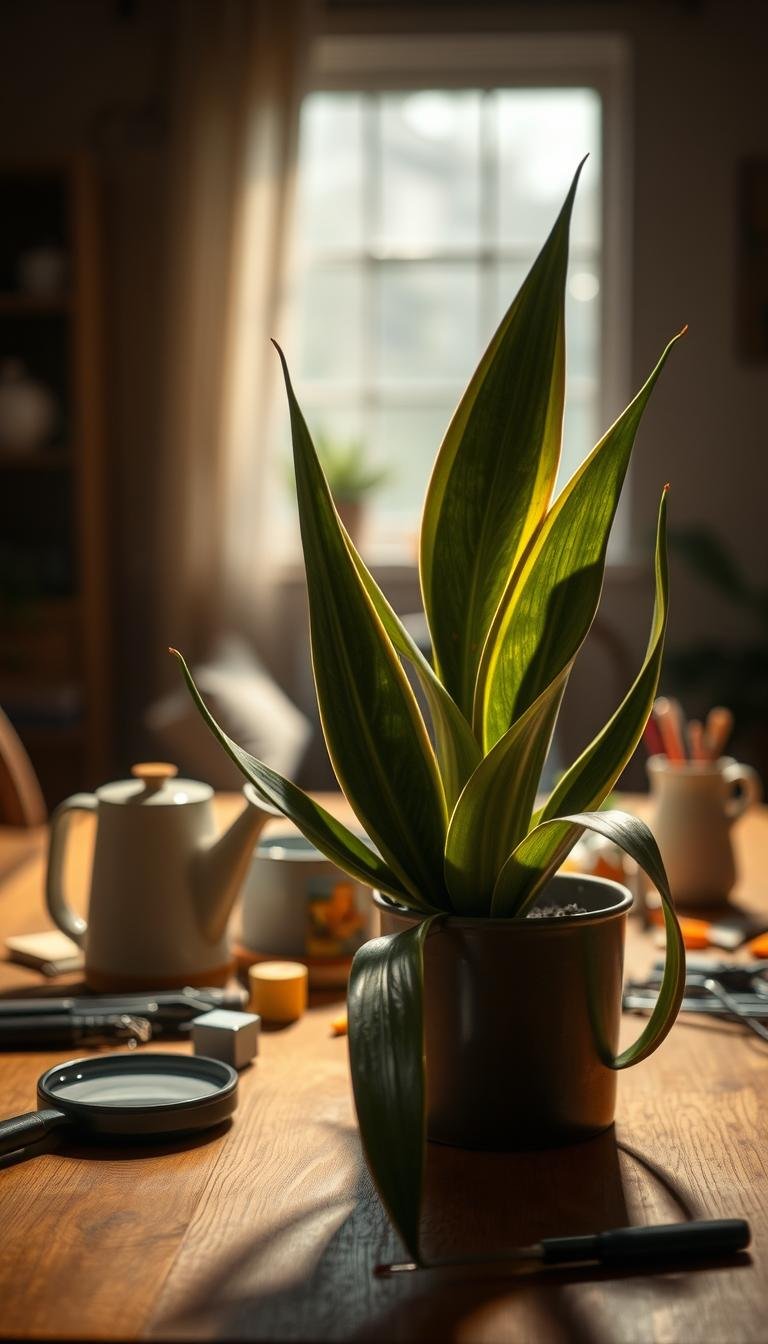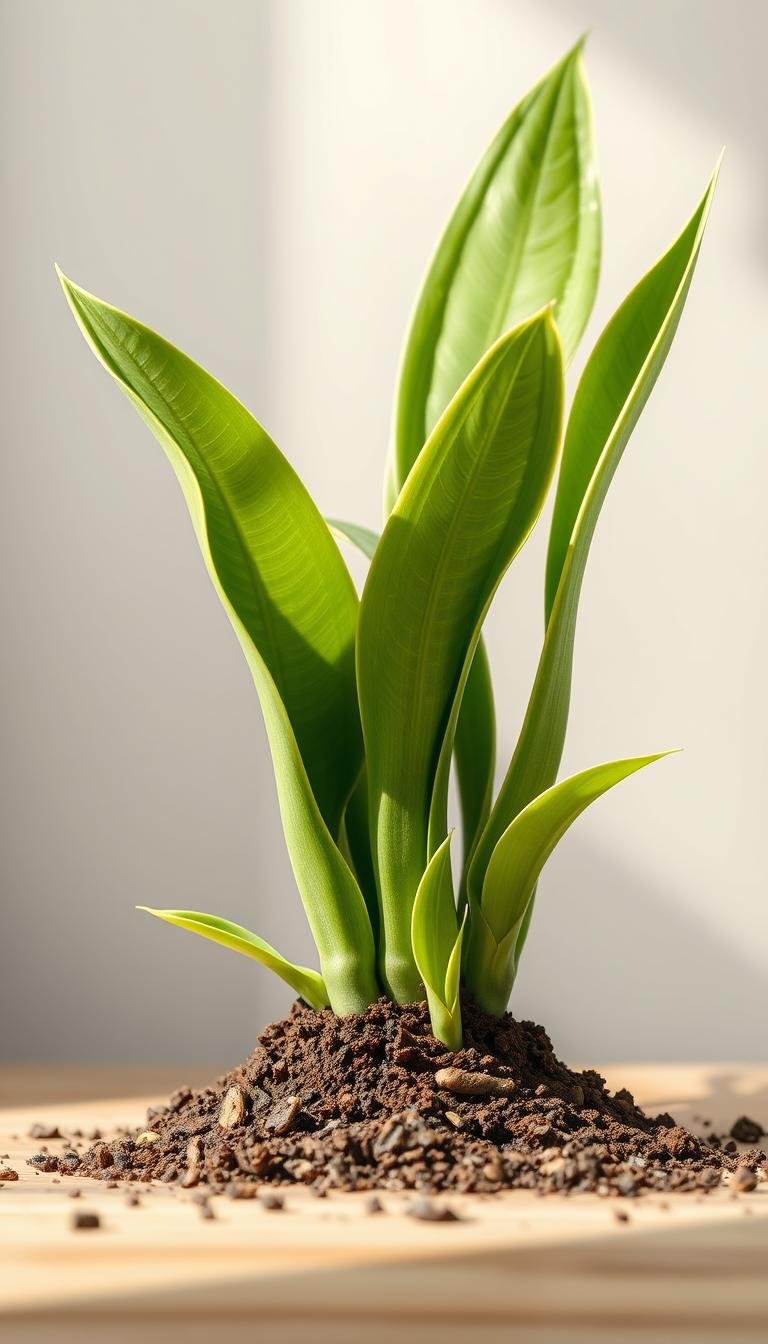This article may contain affiliate links. If you click on these links and make a purchase, we may receive a small commission at no extra cost to you. This helps support our website and allows us to continue to produce content like this. Thank you for your support!
Did you know that snake plants can survive for weeks without water? This hardy houseplant is perfect for busy individuals or those new to indoor gardening. Known for its striking leaves and minimal care requirements, the snake plant is a favorite for many homes.
These plants thrive in various light conditions, from low, indirect light to bright sunlight. Their ability to purify air by removing toxins like formaldehyde makes them both beautiful and functional. Plus, they’re drought-tolerant, so overwatering is rarely an issue.
With varieties like Dracaena trifasciata ‘Laurentii,’ you can enjoy unique colors and textures. Whether you’re a seasoned plant lover or just starting, this guide will help you understand everything from watering tips to propagation techniques. Let’s dive in and explore the world of snake plants!
Key Takeaways
- Snake plants are low-maintenance and ideal for beginners.
- They thrive in various light conditions, from low to bright indirect light.
- These plants purify indoor air by removing toxins.
- Water sparingly, as they are drought-tolerant.
- Propagation is easy through leaf cuttings or division.
- They prefer dry soil and minimal watering.
- Snake plants are mildly toxic to pets, so keep them out of reach.
Understanding Your Snake Plant
With their striking, sword-like leaves, snake plants bring a touch of elegance to any space. Also known as Mother-in-Law’s Tongue, these hardy houseplants are native to Africa. Their stiff, upright leaves give them a unique architectural look, making them a favorite for modern homes.
What Are Snake Plants?
Snake plants are known for their resilience and low-maintenance nature. They thrive in various light conditions, from low to bright indirect light. Their ability to purify air by removing toxins like formaldehyde makes them both beautiful and functional.
These plants prefer dry soil and minimal watering, making them ideal for busy individuals. Their robust nature allows them to survive in less-than-ideal conditions, adding to their popularity as a houseplant.
Popular Varieties and Their Characteristics
There are several varieties of snake plants, each with unique leaf markings and colors. For example, the Dracaena trifasciata ‘Laurentii’ features dark green leaves with yellow edges, adding a pop of color to your home.
Another popular variety is the ‘Bantel’s Sensation,’ known for its narrow leaves with white vertical stripes. The ‘Bird’s Nest’ variety, on the other hand, has short, wide leaves that grow only 6 to 8 inches long.
Understanding the differences between these varieties helps you choose the right one for your space. Whether you prefer bold colors or subtle patterns, there’s a snake plant for every home.
Essential Conditions for Snake Plant Care
Snake plants are renowned for their resilience and adaptability, making them a top choice for indoor greenery. To keep them thriving, it’s important to understand their basic needs. From watering habits to light exposure, these guidelines will help you create the perfect environment for your plant.
Watering Techniques
One of the most common mistakes with snake plants is overwatering. These hardy houseplants prefer dry soil and can go weeks without water. Allow the soil to dry completely between waterings to prevent root rot. In winter, reduce watering frequency as the plant’s growth slows.
Light Requirements
Snake plants thrive in indirect light, making them ideal for various spots in your home. While they can tolerate low light, bright, filtered sunlight encourages healthier growth. Avoid direct sunlight, as it can scorch the leaves.
Temperature and Humidity
These plants prefer warm, average indoor temperatures, ideally between 70-90°F. They can tolerate cooler conditions but should be kept away from drafts. Snake plants are not fussy about humidity, making them suitable for most homes.
By following these simple guidelines, you’ll ensure your snake plant remains healthy and vibrant. Whether you’re a seasoned gardener or a beginner, these tips make care effortless.
Equipment and Materials for Growing Snake Plants
The right equipment and materials are key to ensuring your snake plant thrives indoors. From the perfect pot to the ideal soil mix, every detail matters. Let’s explore how to set up the best environment for your plant’s growth.

Choosing the Right Pot and Well-Draining Soil
Selecting the right pot is crucial for your snake plant’s health. Terracotta pots are a great choice because they allow for better moisture control and aeration. Always opt for pots with drainage holes to prevent waterlogging, which can lead to root rot.
Well-draining soil is equally important. A mix designed for cacti and succulents works best. Add pumice or perlite to improve drainage and ensure the soil doesn’t retain excess moisture. This setup mimics the plant’s natural habitat and promotes healthy root growth.
Selecting Fertilizers and Gardening Tools
Fertilizers can boost your snake plant’s growth, but moderation is key. Use a balanced, water-soluble fertilizer at half-strength during the growing season (spring and summer). Overfeeding can harm the plant, so stick to a schedule of once or twice a year.
For gardening tools, keep it simple. A trowel, pruning shears, and a watering can are essential. These tools make repotting and maintenance tasks easier, ensuring your plant stays vibrant and healthy.
By investing in the right equipment and materials, you’ll create a strong foundation for your snake plant’s long-term success. Whether you’re a beginner or an experienced gardener, these tips will help you achieve thriving results.
How to Care for Snake Plants a Beginner’s Guide
Maintaining a snake plant is simpler than you might think, even for those new to gardening. With a few basic steps, you can ensure your plant stays healthy and vibrant. Let’s dive into the essentials of daily care and maintenance.

Getting Started with Basic Maintenance
Start by cleaning the leaves regularly. Dust can block sunlight, affecting the plant’s growth. Use a damp cloth to gently wipe the leaves, keeping them shiny and healthy.
Check the soil moisture before watering. Snake plants prefer dry soil, so let it dry completely between waterings. Overwatering can lead to root rot, so it’s better to err on the side of caution.
Repotting is rarely needed, as these plants thrive when slightly pot-bound. If roots start to grow out of the drainage holes, it’s time to repot. Use a well-draining soil mix to prevent waterlogging.
Watch for early signs of stress, such as yellowing leaves or wilting. These issues often stem from overwatering or insufficient light. Adjust care routines to address the problem promptly.
Establishing a simple routine early on ensures long-term health. With minimal effort, your snake plant will continue to thrive, adding beauty and clean air to your home.
Troubleshooting Common Snake Plant Issues
Even the hardiest houseplants can face challenges, and snake plants are no exception. While they’re known for their resilience, issues like overwatering, pests, and leaf damage can arise. Understanding these problems and how to address them ensures your plant stays healthy and vibrant.

Dealing with Overwatering and Root Rot
Overwatering is the most common issue with snake plants. Symptoms include yellowing leaves and a mushy base. These signs often indicate root rot, a condition caused by excess moisture in the soil.
To fix this, remove the plant from its pot and inspect the roots. Trim any black or mushy parts using clean shears. Repot the plant in fresh, well-draining soil and a pot with drainage holes. Adjust your watering schedule, allowing the soil to dry completely between waterings.
Prevent future issues by watering sparingly, especially in winter when the plant’s growth slows. A simple rule: when in doubt, wait a few more days before watering.
Pest Management and Leaf Condition
Snake plants are relatively pest-resistant but can occasionally attract mealybugs or spider mites. These pests often appear as small white spots or webbing on the leaves. Early detection is key to managing infestations.
For mealybugs, wipe the leaves with a cotton swab dipped in rubbing alcohol. Spider mites can be treated with insecticidal soap or neem oil. Regularly inspect your plant for signs of pests, especially under the leaves.
Leaf issues like brown tips or spots can result from low humidity, excessive salts, or insufficient light. Trim damaged areas and adjust care routines. Ensure your plant receives bright, indirect light and avoid placing it near drafts.
By staying vigilant and addressing problems promptly, you can keep your snake plant thriving. A little attention goes a long way in maintaining its beauty and health.
Advanced Care Tips for Thriving Snake Plants
Taking your snake plant care to the next level can unlock its full potential and enhance your indoor space. With a few advanced techniques, you can ensure your plant not only survives but thrives. Let’s explore propagation, seasonal adjustments, and aesthetic placement to elevate your gardening skills.

Propagation Techniques and New Plant Babies
Propagating snake plants is a rewarding way to expand your collection. One effective method is leaf cuttings. Cut a healthy leaf into sections, let them dry for a day, and place them in well-draining soil. Roots will form in a few weeks, giving you new plants.
Another technique is division. Gently separate the rhizomes during repotting and plant them in fresh soil. This method ensures faster growth and maintains the parent plant’s characteristics. With these tips, you’ll have a thriving indoor jungle in no time.
Seasonal Care Adjustments and Potting Advice
Adjusting care routines with the seasons keeps your snake plant healthy year-round. In spring and summer, water every 2-3 weeks and provide bright, indirect light. During winter, reduce watering to once a month, as the plant’s growth slows.
Repotting is essential when the plant outgrows its pot or the soil becomes compacted. Use a well-draining mix and a pot with drainage holes to prevent waterlogging. These adjustments ensure continuous growth and vitality.
Enhancing Plant Aesthetics and Indoor Placement
Strategic placement can transform your snake plant into a stunning focal point. Place it near a window with indirect light to highlight its unique leaf patterns. Group it with other houseplants for a lush, layered look.
For added flair, use decorative pots that complement your home’s decor. Rotate the plant occasionally to ensure even growth and maintain its shape. These subtle techniques maximize visual appeal and create a harmonious indoor environment.
Conclusion
With their air-purifying qualities and striking appearance, snake plants are a perfect addition to any home. These resilient houseplants thrive with minimal effort, making them ideal for both beginners and experienced gardeners. Proper care involves using well-draining soil, watering sparingly, and providing bright, indirect light.
For those looking to expand their skills, propagation through cuttings or division is simple and rewarding. Addressing common issues like overwatering or pests ensures your plant remains healthy. With their ability to purify air and adapt to various conditions, snake plants bring beauty and benefits to any space.
By following these guidelines, you’ll enjoy a thriving plant that enhances your home for years to come. Embrace the simplicity and elegance of snake plants, and let them transform your indoor environment effortlessly.



